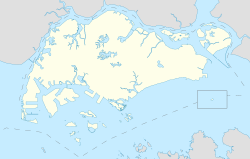| Central Catchment Nature Reserve | |
|---|---|
 | |
| Type | Nature reserve |
| Location | Singapore |
| Coordinates | 01°22′N103°48′E / 1.367°N 103.800°E |
| Area | 2,880 hectares (28.8 km2) |
| Status | Open |
The Central Catchment Nature Reserve [a] (CCNR) is the largest nature reserve in Singapore, occupying 2880 hectares. [2] Forming a large green lung in the geographical centre of the city, it houses several recreational sites, including the Singapore Zoo, the Night Safari and the River Safari, as well as several newer facilities built to encourage public appreciation of the reserve, such as the HSBC TreeTop Walk. The reserve sits within the boundaries of the Central Water Catchment. [3] It is one of the four gazetted nature reserves in Singapore. The other three are the Labrador Nature Reserve [4] which was gazetted since 1 January 2002, Sungei Buloh Wetland Reserve [5] and Bukit Timah Nature Reserve. [6] All four nature reserves along with the parks are protected under the Parks & Trees Act 2005.
Contents
- Attractions
- Biodiversity
- HSBC TreeTop Walk
- Conservation
- Banded leaf monkey conservation
- See also
- Notes
- References
- External links
The nature reserve acts as a catchment area for the surrounding reservoirs. The country's main reservoirs – MacRitchie, Upper Seletar, Upper Peirce and Lower Peirce are located within the reserve. [7] [8]
Most forests in the CCNR were cleared for logging and cultivation unlike Bukit Timah Nature Reserve, which remain relatively undisturbed. The CCNR now consists of a mixture of young and mature secondary forests with virgin primary forest surrounding the reservoirs. [9]

